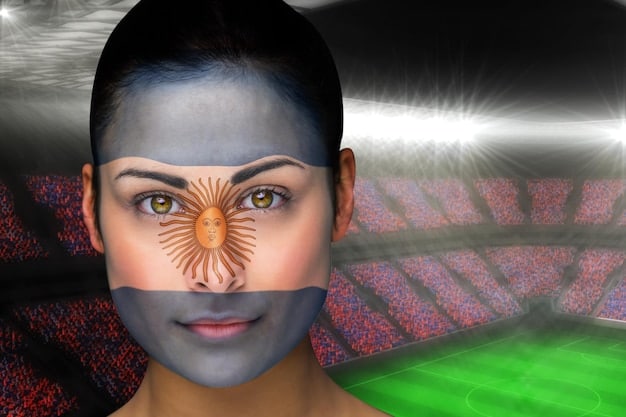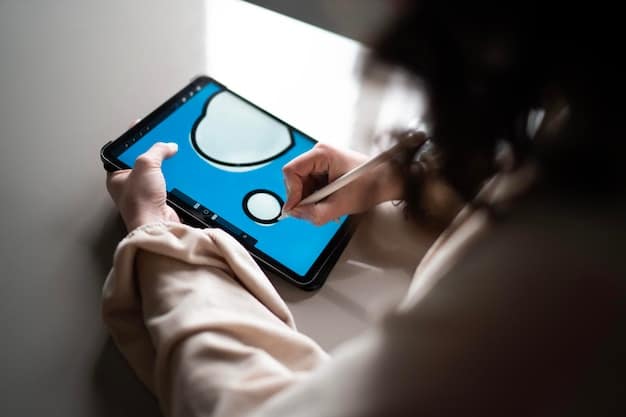Spotting Deepfakes: Is It Real or Fake in Viral Content?

Anúncios
Deepfakes and misinformation are increasingly prevalent in today’s viral content, making it essential to understand how to identify manipulated media and verify the authenticity of information before sharing it.
In today’s digital age, discerning what’s genuine from what’s fabricated online has become a critical skill. The proliferation of is it real or fake? Spotting deepfakes and misinformation in today’s viral content is a growing challenge, but understanding the techniques used and the telltale signs can empower you to navigate the digital landscape with confidence.
Anúncios
Understanding the Rise of Deepfakes
Deepfakes, a portmanteau of “deep learning” and “fake,” represent a significant advancement in artificial intelligence with potentially damaging consequences. They use sophisticated algorithms to manipulate visual and audio content, often blurring the line between reality and fabrication.
What are Deepfakes?
Deepfakes are essentially AI-generated media where a person in an existing image or video is replaced with someone else’s likeness. The technology has evolved rapidly, making it increasingly difficult to distinguish deepfakes from genuine content.
Anúncios
The Different Types of Deepfakes
Deepfakes come in various forms, from simple face-swapping to more elaborate manipulations that involve altering speech, expressions, and even entire scenarios. Understanding these nuances is key to spotting them.
- Face Swaps: These involve overlaying one person’s face onto another’s body in a video or image.
- Lip-Syncing: Altering the lip movements in a video to make it appear as if someone is saying something they never did.
- Entire Scenario Manipulation: Creating entirely fabricated scenes using AI, with realistic-looking people and environments.

The motivations behind creating deepfakes are diverse, ranging from harmless entertainment to malicious attempts at spreading misinformation, damaging reputations, or even influencing political outcomes. Recognizing the potential harm can help you approach viral content with a critical eye.
Identifying the Tell-Tale Signs of a Deepfake
Spotting a deepfake requires a keen eye and an understanding of the common flaws in these artificial creations. While the technology is improving, there are still several indicators that can raise red flags.
Visual Discrepancies
One of the first things to look for is visual inconsistencies, such as blurring, pixelation, or unnatural lighting around the face or mouth. AI algorithms are not always perfect, and imperfections can be a giveaway.
Audio Anomalies
Audio quality is another area where deepfakes often fall short. Listen for robotic voices, unnatural pauses, or a mismatch between the audio and video. Sometimes the audio might sound disjointed or out of sync with the speaker’s lip movements.
- Inconsistent Lighting: Shadows and highlights that don’t match the environment.
- Unnatural Blinking: Deepfake algorithms sometimes struggle with replicating natural blinking patterns.
- Distorted Audio: Robotic or synthesized voices that lack natural human inflection.
While visual and audio cues can be helpful, they are not always definitive. As technology advances, deepfakes become more sophisticated, making it essential to employ a multi-faceted approach to verification.
The Role of Critical Thinking in Disinformation Detection
Beyond technical indicators, critical thinking plays a crucial role in identifying disinformation. This involves questioning the source, context, and motives behind the content you encounter online.
Question the Source
Before accepting information as fact, consider the source. Is it a reputable news organization, a verified expert, or an unknown account with a history of spreading questionable content?
Check the Context
Examine the surrounding context of the information. Is it presented in a sensationalized or biased manner? Are there any inconsistencies or logical fallacies in the narrative?
- Verify the Website’s Reputation: Check if the site is known for accuracy and journalistic integrity.
- Look for “About Us” Information: Transparent websites provide details about their ownership and editorial policies.
- Read Comments and Reviews: See what other users and experts are saying about the site’s credibility.
By applying critical thinking skills, you can develop a more discerning approach to online content and reduce your susceptibility to manipulation.
Utilizing Fact-Checking Resources and Tools
Numerous fact-checking organizations and tools are available to help verify information and debunk misinformation. These resources can provide valuable insights and help you separate fact from fiction.
Reliable Fact-Checking Websites
Websites like Snopes, PolitiFact, and FactCheck.org are dedicated to verifying claims and reporting on the accuracy of information circulating online. These sites employ teams of experienced journalists and researchers who investigate claims and provide detailed analyses.
Image and Video Verification Tools
Reverse image search tools, such as Google Image Search and TinEye, can help you determine if an image or video has been altered or taken out of context. These tools allow you to upload an image and search for other instances of it online, helping you identify its origin and track its use.

Leveraging these resources can empower you to become a more informed and responsible consumer of online content, contributing to a more accurate and trustworthy information ecosystem.
Protecting Yourself from Misinformation
Beyond identifying deepfakes and misinformation, it’s essential to take steps to protect yourself from being manipulated or deceived. This involves cultivating healthy online habits and being mindful of the information you consume and share.
Cultivate Healthy Online Habits
Avoid blindly accepting information at face value and always question the validity of claims. Take the time to verify information before sharing it, and be wary of emotionally charged content or sensationalized headlines.
Be Mindful of What You Share
Think before you share. Misinformation spreads rapidly online, and even well-intentioned individuals can inadvertently contribute to its dissemination. Be sure to verify information before sharing it on social media or with your friends and family.
- Adjust Privacy Settings: Control who can see your posts and information on social media.
- Use Strong Passwords: Protect your accounts from unauthorized access.
- Be Cautious of Phishing Scams: Don’t click on suspicious links or provide personal information to untrusted sources.
By adopting these protective measures, you can reduce your vulnerability to misinformation and contribute to a more informed and responsible online environment.
The Future of Deepfakes and Disinformation
The battle against deepfakes and misinformation is an ongoing challenge, with technology evolving at a rapid pace. As AI becomes more sophisticated, it will become increasingly difficult to distinguish between real and fake content. Therefore, adaptability and continuous learning are crucial.
The Evolving Threat Landscape
Deepfakes are likely to become more realistic and harder to detect, necessitating the development of more sophisticated detection methods. This could include AI-powered tools that can analyze subtle cues and patterns in media to identify manipulations.
Staying Informed and Adaptive
Staying informed about the latest developments in deepfake technology and disinformation tactics is essential. This includes following reputable news sources, attending workshops or webinars, and engaging in discussions with experts in the field.
By embracing adaptability and committing to continuous learning, you can stay ahead of the curve and protect yourself from the evolving threats of deepfakes and misinformation.
| Key Point | Brief Description |
|---|---|
| 💡 Visual Discrepancies | Look for blurring, pixelation, or unnatural lighting. |
| 👂 Audio Anomalies | Listen for robotic voices or mismatched lip movements. |
| 🤔 Critical Thinking | Question the source and context of information. |
| ✅ Fact-Checking Tools | Use resources like Snopes and reverse image search. |
What are deepfakes?
▼
Deepfakes are AI-synthesized media where a person’s likeness is swapped with another, often used to create convincing but false videos or images.”,”What are some telltale signs of a deepfake?
▼
Look for visual inconsistencies like blurring around the face, unnatural lighting, and audio anomalies such as robotic voices or mismatched lip movements.”,”How can I verify the source of information?
▼
Check the reputation of the website, look for “About Us” information, and read comments and reviews to assess the source’s credibility and history of accuracy.”,”What are some reliable fact-checking websites?
▼
Reliable fact-checking websites include Snopes, PolitiFact, and FactCheck.org, which are dedicated to verifying claims and debunking misinformation online.”,”How can I protect myself from misinformation?
▼
Cultivate healthy online habits by questioning information, verifying facts before sharing, and adjusting your privacy settings to control your exposure and vulnerability.
In an era where digital realities can be easily manipulated, discerning the truth from falsehood is paramount. By understanding the nature of deepfakes, employing critical thinking, utilizing fact-checking tools, and cultivating healthy online habits, you can navigate the digital landscape with greater confidence and protect yourself from the pervasive threat of misinformation.
Viral Moments





